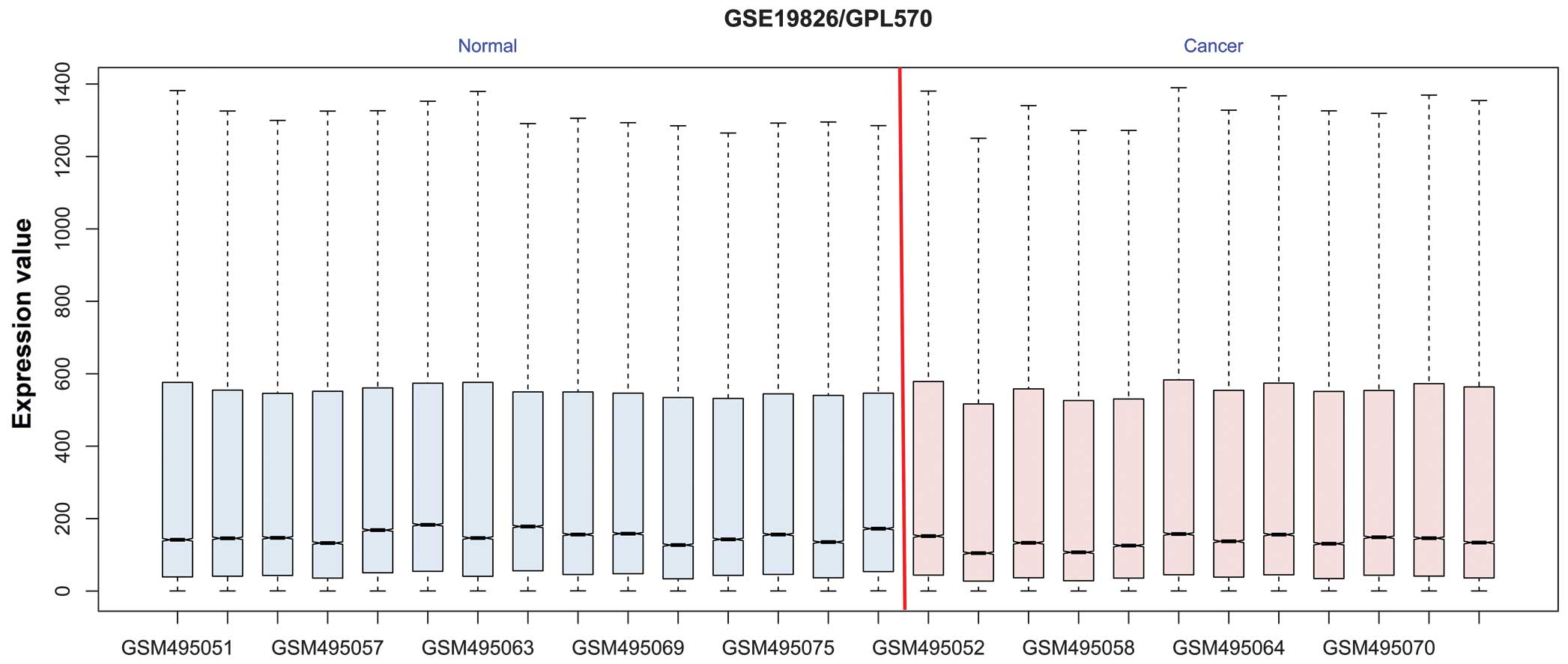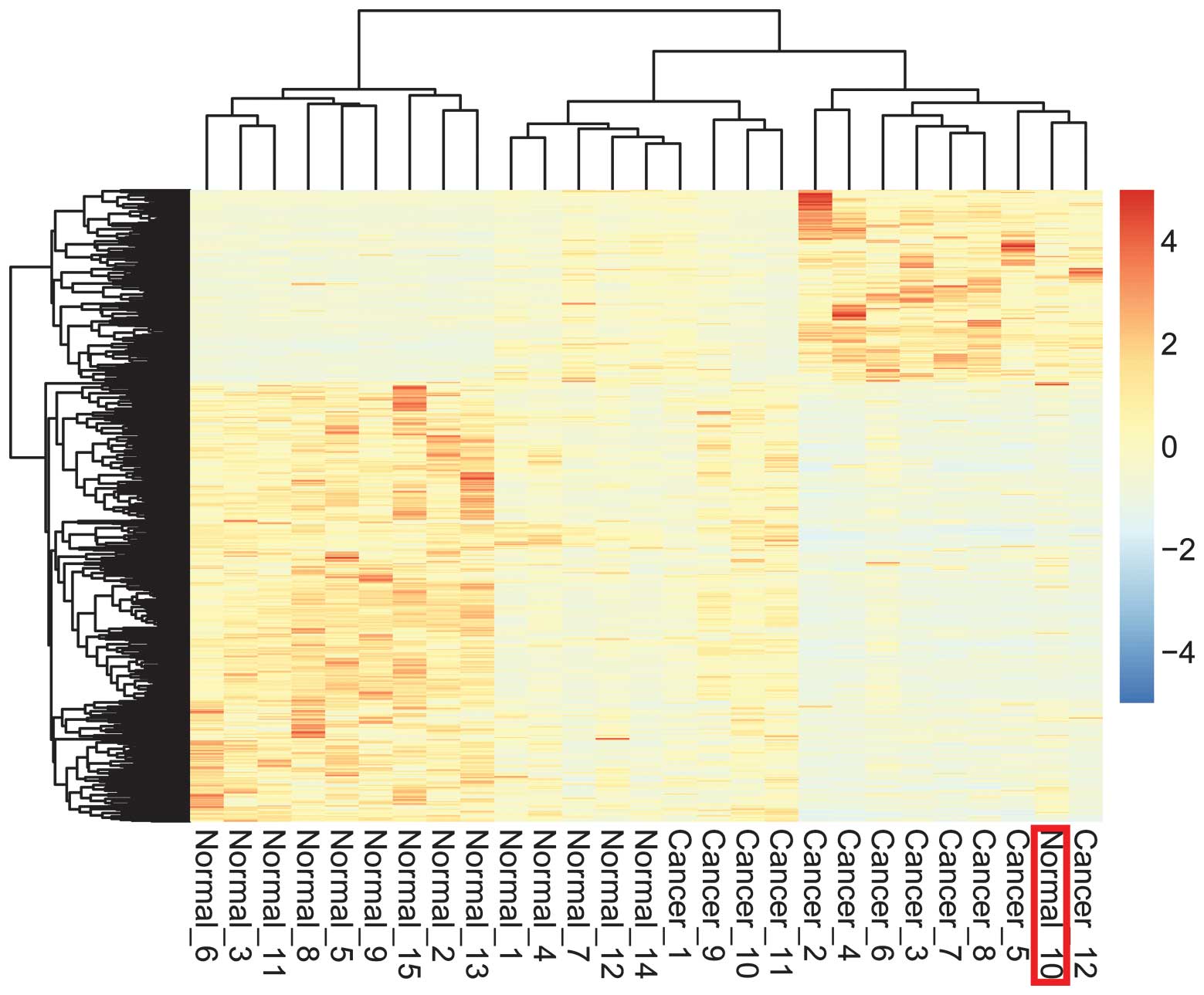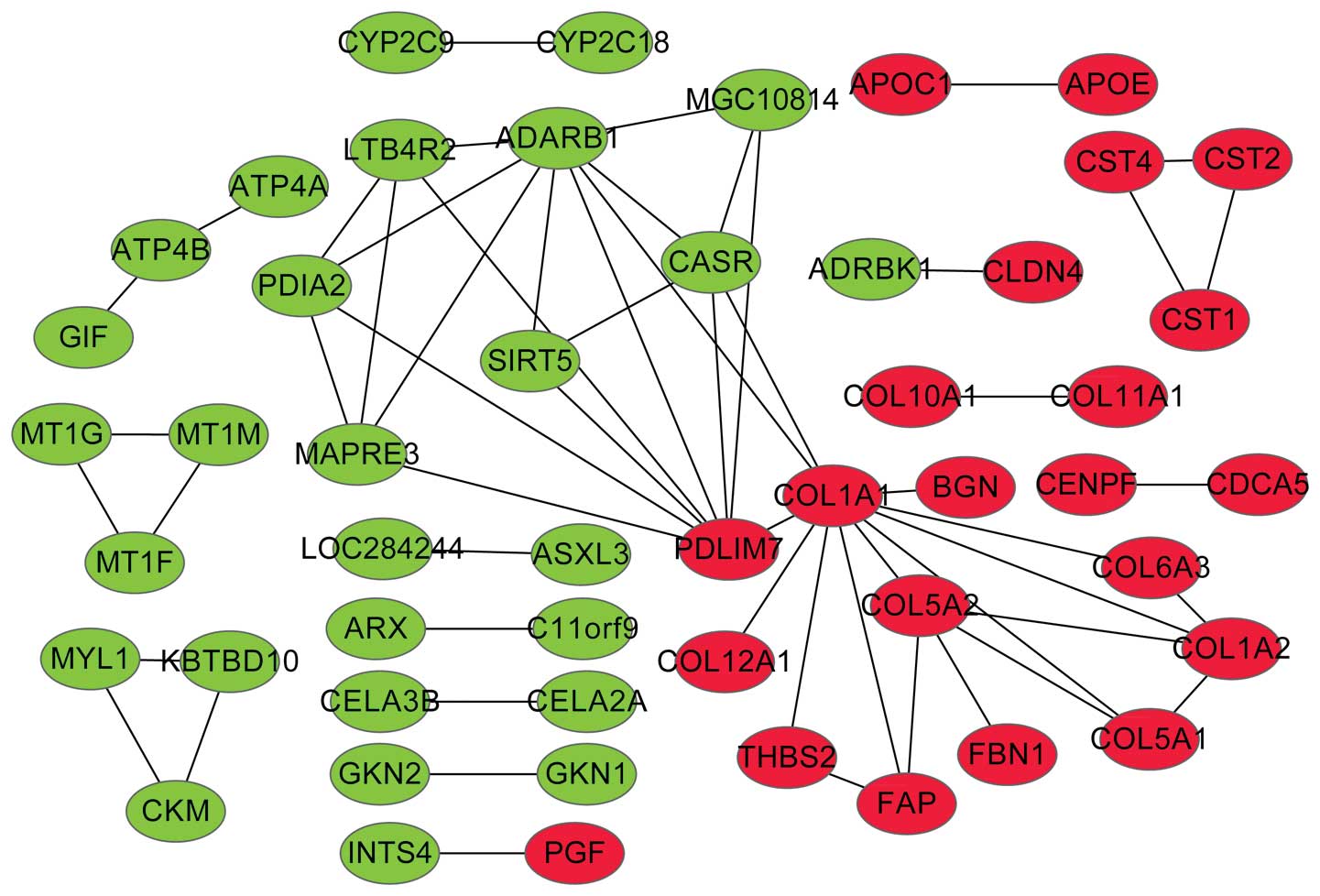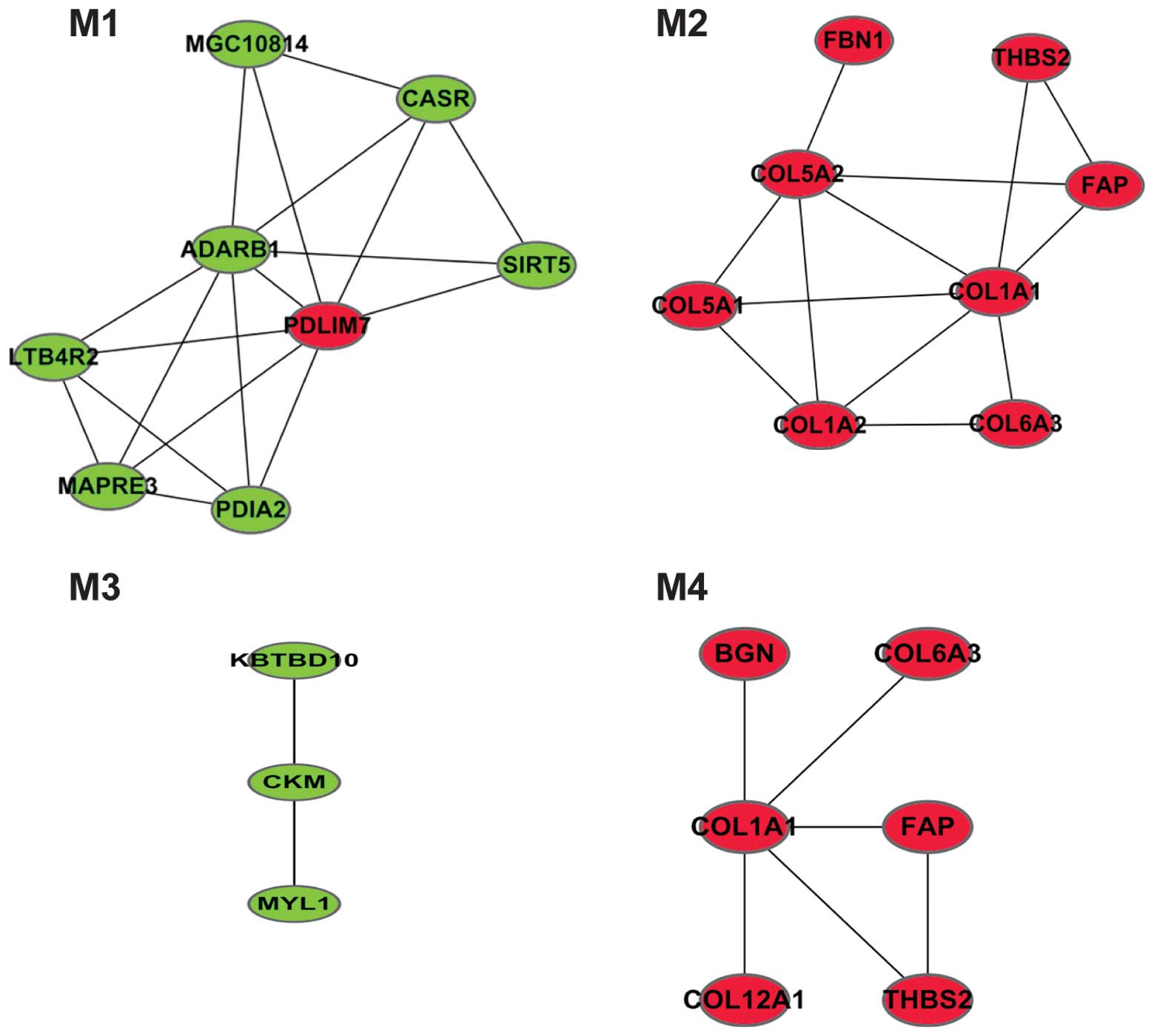|
1
|
Polk DB and Peek RM Jr: Helicobacter
pylori: Gastric cancer and beyond. Nat Rev Cancer. 10:403–414.
2010. View
Article : Google Scholar : PubMed/NCBI
|
|
2
|
Ferlay J, Shin HR, Bray F, Forman D,
Mathers C and Parkin DM: Estimates of worldwide burden of cancer in
2008: GLOBOCAN 2008. Int J Cancer. 127:2893–2917. 2010. View Article : Google Scholar : PubMed/NCBI
|
|
3
|
Schønnemann K, Jensen HA, Yilmaz M, Jensen
BV, Larsen O and Pfeiffer P: Phase II study of short-time
oxaliplatin, capecitabine and epirubicin (EXE) as first-line
therapy in patients with non-resectable gastric cancer. Br J
Cancer. 99:858–861. 2008. View Article : Google Scholar : PubMed/NCBI
|
|
4
|
Cunningham D, Allum WH, Stenning SP,
Thompson JN, Van de Velde CJ, Nicolson M, Scarffe JH, Lofts FJ,
Falk SJ, Iveson TJ, et al: Perioperative chemotherapy versus
surgery alone for resectable gastroesophageal cancer. N Engl J Med.
355:11–20. 2006. View Article : Google Scholar : PubMed/NCBI
|
|
5
|
Guggenheim DE and Shah MA: Gastric cancer
epidemiology and risk factors. J Surg Oncol. 107:230–236. 2013.
View Article : Google Scholar : PubMed/NCBI
|
|
6
|
Tang W, Nakamura Y, Tsujimoto M, Sato M,
Wang X, Kurozumi K, Nakahara M, Nakao K, Nakamura M, Mori I and
Kakudo K: Heparanase: A key enzyme in invasion and metastasis of
gastric carcinoma. Mod Pathol. 15:593–598. 2002. View Article : Google Scholar : PubMed/NCBI
|
|
7
|
Gupta GP and Massagué J: Cancer
metastasis: Building a framework. Cell. 127:679–695. 2006.
View Article : Google Scholar : PubMed/NCBI
|
|
8
|
Yasui W, Oue N, Ito R, Kuraoka K and
Nakayama H: Search for new biomarkers of gastric cancer through
serial analysis of gene expression and its clinical implications.
Cancer Sci. 95:385–392. 2004. View Article : Google Scholar : PubMed/NCBI
|
|
9
|
Yasui W, Oue N, Aung PP, Matsumura S,
Shutoh M and Nakayama H: Molecular-pathological prognostic factors
of gastric cancer: A review. Gastric cancer. 8:86–94. 2005.
View Article : Google Scholar : PubMed/NCBI
|
|
10
|
Kim JM, Sohn HY, Yoon SY, Oh JH, Yang JO,
Kim JH, Song KS, Rho SM, Yoo HS, Kim YS, et al: Identification of
gastric cancer-related genes using a cDNA microarray containing
novel expressed sequence tags expressed in gastric cancer cells.
Clin Cancer Res. 11:473–482. 2005.PubMed/NCBI
|
|
11
|
Li BS, Zhao YL, Guo G, Li W, Zhu ED, Luo
X, Mao XH, Zou QM, Yu PW, Zuo QF, et al: Plasma microRNAs, miR-223,
miR-21 and miR-218, as novel potential biomarkers for gastric
cancer detection. PLoS One. 7:e416292012. View Article : Google Scholar : PubMed/NCBI
|
|
12
|
Wu MS, Lin YS, Chang YT, Shun CT, Lin MT
and Lin JT: Gene expression profiling of gastric cancer by
microarray combined with laser capture microdissection. World J
Gastroenterol. 11:7405–7412. 2005.PubMed/NCBI
|
|
13
|
Yokozaki H, Yasui W and Tahara E: Genetic
and epigenetic changes in stomach cancer. Int Rev Cytol. 204:49–95.
2001. View Article : Google Scholar : PubMed/NCBI
|
|
14
|
Rubin MA, Mucci NR, Figurski J, Fecko A,
Pienta KJ and Day ML: E-cadherin expression in prostate cancer: A
broad survey using high-density tissue microarray technology. Hum
Pathol. 32:690–697. 2001. View Article : Google Scholar : PubMed/NCBI
|
|
15
|
Ajani JA: Evolving chemotherapy for
advanced gastric cancer. Oncologist. 10(Suppl): 49–58. 2005.
View Article : Google Scholar : PubMed/NCBI
|
|
16
|
Wang Q, Wen YG, Li DP, Xia J, Zhou CZ, Yan
DW, Tang HM and Peng ZH: Upregulated INHBA expression is associated
with poor survival in gastric cancer. Med Oncol. 29:77–83. 2012.
View Article : Google Scholar : PubMed/NCBI
|
|
17
|
Liu P, Wang X, Hu C and Hu T:
Bioinformatics analysis with graph-based clustering to detect
gastric cancer-related pathways. Genet Mol Res. 11:3497–3504. 2012.
View Article : Google Scholar : PubMed/NCBI
|
|
18
|
Kikuchi Y, Kunita A, Iwata C, Komura D,
Nishiyama T, Shimazu K, Takeshita K, Shibahara J, Kii I, Morishita
Y, et al: The niche component periostin is produced by
cancer-associated fibroblasts, supporting growth of gastric cancer
through ERK activation. Am J Pathol. 184:859–870. 2014. View Article : Google Scholar : PubMed/NCBI
|
|
19
|
Barrett T, Troup DB, Wilhite SE, Ledoux P,
Rudnev D, Evangelista C, Kim IF, Soboleva A, Tomashevsky M, Edgar
R, et al: NCBI GEO: mining tens of millions of expression
profiles-database and tools update. Nucleic Acids Res. 35(Database
Issue): D760–D765. 2007. View Article : Google Scholar : PubMed/NCBI
|
|
20
|
Smyth GK: Limma: Linear models for
microarray data. Bioinformatics and Computational Biology Solutions
Using R and Bioconductor. Gentleman R, Carey V, Dudoit S, Irizarry
R and Huber W: Springer. 397–420. 2005. View Article : Google Scholar
|
|
21
|
Ihaka R and Gentleman R: R: A language for
data analysis and graphics. J Comput Graph Stat. 5:299–314. 1996.
View Article : Google Scholar
|
|
22
|
Reiner-Benaim A: FDR control by the BH
procedure for two-sided correlated tests with implications to gene
expression data analysis. Biom J. 49:107–126. 2007. View Article : Google Scholar : PubMed/NCBI
|
|
23
|
Benjamini Y and Hochberg Y: Controlling
the false discovery rate: A practical and powerful approach to
multiple testing. J R Statist Soc B. 57:289–300. 1995.
|
|
24
|
Szekely GJ and Rizzo ML: Hierarchical
clustering via joint between-within distances: Extending Ward's
minimum variance method. J Classif. 22:151–183. 2005. View Article : Google Scholar
|
|
25
|
Deza MM and Deza E: Encyclopedia of
distances. Berlin: Springer-Verlag. 2009. View Article : Google Scholar
|
|
26
|
Diao H, Li X, Hu S and Liu Y: Gene
expression profiling combined with bioinformatics analysis identify
biomarkers for Parkinson disease. PLoS One. 7:e523192012.
View Article : Google Scholar : PubMed/NCBI
|
|
27
|
Obayashi T, Okamura Y, Ito S, Tadaka S,
Motoike IN and Kinoshita K: COXPRESdb: A database of comparative
gene coexpression networks of eleven species for mammals. Nucleic
Acids Res. 41(Database Issue): D1014–D1020. 2013. View Article : Google Scholar : PubMed/NCBI
|
|
28
|
Barabasi AL and Oltvai ZN: Network
biology: Understanding the cell's functional organization. Nat Rev
Genet. 5:101–113. 2004. View
Article : Google Scholar : PubMed/NCBI
|
|
29
|
Smoot ME, Ono K, Ruscheinski J, Wang PL
and Ideker T: Cytoscape 2.8: New features for data integration and
network visualization. Bioinformatics. 27:431–432. 2011. View Article : Google Scholar : PubMed/NCBI
|
|
30
|
Bader GD and Hogue CW: An automated method
for finding molecular complexes in large protein interaction
networks. BMC Bioinformatics. 4:22003. View Article : Google Scholar : PubMed/NCBI
|
|
31
|
Maere S, Heymans K and Kuiper M: BiNGO: A
Cytoscape plugin to assess overrepresentation of gene ontology
categories in biological networks. Bioinformatics. 21:3448–3449.
2005. View Article : Google Scholar : PubMed/NCBI
|
|
32
|
da Huang W, Sherman BT and Lempicki RA:
Systematic and integrative analysis of large gene lists using DAVID
bioinformatics resources. Nat Protoc. 4:44–57. 2009. View Article : Google Scholar : PubMed/NCBI
|
|
33
|
Jemal A, Bray F, Center MM, Ferlay J, Ward
E and Forman D: Global cancer statistics. CA Cancer J Clin.
61:69–90. 2011. View Article : Google Scholar : PubMed/NCBI
|
|
34
|
Figueiredo C, GarciaGonzalez MA and
Machado JC: Molecular pathogenesis of gastric cancer. Helicobacter.
18(Suppl 1): 28–33. 2013. View Article : Google Scholar : PubMed/NCBI
|
|
35
|
Guttula SV, Allam A and Gumpeny RS:
Analyzing microarray data of Alzheimer's using cluster analysis to
identify the biomarker genes. Int J Alzheimers Dis.
2012:6494562012.PubMed/NCBI
|
|
36
|
Chan TF, Poon A, Basu A, Addleman NR, Chen
J, Phong A, Byers PH, Klein TE and Kwok PY: Natural variation in
four human collagen genes across an ethnically diverse population.
Genomics. 91:307–314. 2008. View Article : Google Scholar : PubMed/NCBI
|
|
37
|
Yin Y, Zhao Y, Li AQ and Si JM: Collagen:
A possible prediction mark for gastric cancer. Med Hypotheses.
72:163–165. 2009. View Article : Google Scholar : PubMed/NCBI
|
|
38
|
Bosman FT and Stamenkovic I: Functional
structure and composition of the extracellular matrix. J Pathol.
200:423–428. 2003. View Article : Google Scholar : PubMed/NCBI
|
|
39
|
Uitto VJ and Larjava H: Extracellular
matrix molecules and their receptors: An overview with special
emphasis on periodontal tissues. Crit Rev Oral Biol Med. 2:323–354.
1991.PubMed/NCBI
|
|
40
|
Matsui H, Kubochi K, Okazaki I, Yoshino K,
Ishibiki K and Kitajima M: Collagen biosynthesis in gastric cancer:
Immunohistochemical analysis of prolyl 4hydroxylase. J Surg Oncol.
70:239–246. 1999. View Article : Google Scholar : PubMed/NCBI
|
|
41
|
Hippo Y, Taniguchi H, Tsutsumi S, Machida
N, Chong JM, Fukayama M, Kodama T and Aburatani H: Global gene
expression analysis of gastric cancer by oligonucleotide
microarrays. Cancer Res. 62:233–240. 2002.PubMed/NCBI
|
|
42
|
Oue N, Hamai Y, Mitani Y, Matsumura S,
Oshimo Y, Aung PP, Kuraoka K, Nakayama H and Yasui W: Gene
expression profile of gastric carcinoma identification of genes and
tags potentially involved in invasion, metastasis and
carcinogenesis by serial analysis of gene expression. Cancer Res.
64:2397–2405. 2004. View Article : Google Scholar : PubMed/NCBI
|
|
43
|
Tokunaga T, Nakamura M, Oshika Y, Abe Y,
Ozeki Y, Fukushima Y, Hatanaka H, Sadahiro S, Kijima H, Tsuchida T,
et al: Thrombospondin 2 expression is correlated with inhibition of
angiogenesis and metastasis of colon cancer. Br J Cancer.
79:354–359. 1999. View Article : Google Scholar : PubMed/NCBI
|
|
44
|
Stamper BD, Park SS, Beyer RP, Bammler TK,
Farin FM, Mecham B and Cunningham ML: Differential expression of
extracellular matrix-mediated pathways in single-suture
craniosynostosis. PLoS One. 6:e265572011. View Article : Google Scholar : PubMed/NCBI
|
|
45
|
Su CQ, Qiu H and Zhang Y: Localization of
keratin mRNA and collagen I mRNA in gastric cancer by in situ
hybridization and hybridization electron microscopy. World J
Gastroenterol. 5:527–530. 1999.PubMed/NCBI
|
|
46
|
Wu R, Durick K, Songyang Z, Cantley LC,
Taylor SS and Gill GN: Specificity of LIM domain interactions with
receptor tyrosine kinases. J Biol Chem. 271:15934–15941. 1996.
View Article : Google Scholar : PubMed/NCBI
|
|
47
|
Gschwind A, Fischer OM and Ullrich A: The
discovery of receptor tyrosine kinases: Targets for cancer therapy.
Nat Rev Cancer. 4:361–370. 2004. View
Article : Google Scholar : PubMed/NCBI
|
|
48
|
Mittaz L, Scott HS, Rossier C, Seeburg PH,
Higuchi M and Antonarakis SE: Cloning of a human RNA editing
deaminase (ADARB1) of glutamate receptors that maps to chromosome
21q22. 3. Genomics. 41:210–217. 1997. View Article : Google Scholar : PubMed/NCBI
|
|
49
|
Miura K, Fujibuchi W and Sasaki I:
Alternative premRNA splicing in digestive tract malignancy. Cancer
Sci. 102:309–316. 2011. View Article : Google Scholar : PubMed/NCBI
|
|
50
|
Camarata T, Krcmery J, Snyder D, Park S,
Topczewski J and Simon HG: Pdlim7 (LMP4) regulation of Tbx5
specifies zebrafish heart atrio-ventricular boundary and valve
formation. Dev Biol. 337:233–245. 2010. View Article : Google Scholar : PubMed/NCBI
|













